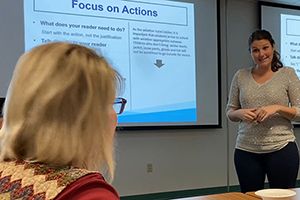Cultivating Donors
I want to start building my donor base. What’s the first step?
Develop a plan. The plan will provide a clear picture of your goals, how you intend to meet those goals and how you will measure success. It will also help you with the more detailed parts of your fundraising efforts.
What goals do I need other than to raise X number of dollars?
You can’t always measure successful fundraising by dollars raised. With both individual and corporate donors, one measure of success is the number of donors who contribute to your campaign.
For example, if you send out an appeal letter that generates a 7% greater dollar amount than your target goal, but you have a 10% drop in the number of donors, that is a concern. You lost diversity in your donor base.
In addition to dollars raised, you also should have goals related to the:
- number of repeat donors: Getting new donors takes more time and effort; it’s more efficient to keep the donors you have.
- length of time that individual donors have contributed: According to “Building Donor Loyalty” on the Fund-Raising Forum, “…the longer a donor gives to an organization the more likely those gifts are to grow in size and frequency.” Donors who started out by giving to a special event might eventually become major gift donors.
Who should I target to grow my donor base?
- Your volunteers: Studies show that people who volunteer are more likely to donate generously. Volunteers already feel the importance of helping in the community, and they may be more inclined to donate to your organization because they feel a connection to it.
- Your former donors: Maybe they stopped donating because of life circumstances or maybe you have a new program or campaign that they might be interested in supporting. Regardless, it never hurts to reconnect.
- People who have attended your special events: Event participants or people who have made a pledge for a participant, already have a connection to your organization. Follow up and let them know how they can continue to support the organization’s mission.
- In reality, every person you meet should be treated as a potential donor. You never know who might provide a critical link to a donor in the community or might one day be in a position to donate to your organization.
What should I include in my plan?
Remember that working with donors is really about relationship building. Consider what you know about individuals and how best
you can nurture a relationship.
Tips for cultivating donors:
- Thank them with a note, in person, by phone. Take advantage of every opportunity to show your gratitude; don’t wait until you plan to make an ask. All donors should feel appreciated.
- Ask donors why they donated to your organization. Did they have a relative or friend who struggled with literacy? Do they work for a company that is connected to the cause of literacy? Have they tutored in the past?
- Keep track of the reasons and use them to personalize your interaction with donors. In appeal letters, touch on the reasons donors have contributed to your organization.
- Offer to get them more involved. Consider what you know about individual donors to determine appropriate volunteer roles –tutoring, serving on the board or a committee, coordinating a special event – and then offer the opportunity. Even if they decline, donors will feel honored that you asked.
- Stay in touch. Tell donors what is happening in your organization so they know that their money is being put to good use. In addition to your newsletter, send personalized e-mails with an anecdote from a tutor report and a note saying, “Thanks for making this happen!” This is another way to nurture your relationships with donors without asking for a donation.
- Make the ask. One of the top reasons people give is because they were asked.
- Give it time. It will take time, but focusing on relationship building will pay off with a dedicated and responsive donor base.




